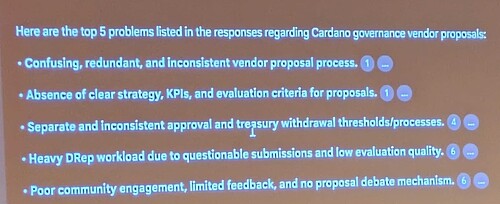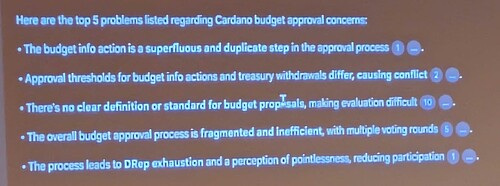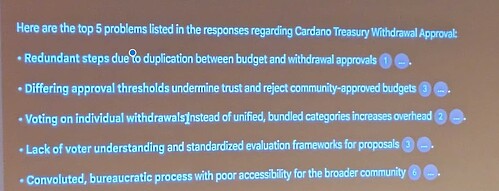The second day of the Cardano: Las Vegas Governance Workshops 2025, hosted by IOG, was split into two parts. The morning session focused on the Cardano Budget Process, and the afternoon was spent exploring the concept of an Executive Function.
Morning Session: The Budget Process
The day began with a discussion on the 2025 budget process, reflecting on its mechanics, challenges, and potential improvements.
The Cost of Governance
One presentation highlighted the administrative overhead of the current process. A rough calculation estimated the total cost to the ecosystem for the 2025 budget cycle at $7.8 million USD, which is about 78,000 hours or 30 work-years.
Key Areas of Discussion & Feedback
Participants broke into groups to identify problems within four key areas of the budget process. Feedback was collected and analyzed to identify the top five concerns for each area, which were then voted on by the attendees.
1. Strategy Setting & The Net Change Limit (NCL)
Discussions showed uncertainty around the NCL.
- Lack of Clear Definition: A primary issue is that the constitution is not specific about how the NCL is calculated, whether it is based only on treasury outflows, or should it consider inflows as well?
- Missing Link to Priorities: The NCL is currently set in isolation, at the moment based on historical treasury inflows, rather than being tied to an ecosystem strategy and clear priorities. This led many to feel like they were setting an arbitrary number disconnected from actual needs.
2. Governance Vendor Proposals
The process for submitting and evaluating proposals was a source of issues. The top-voted problem was the “Absence of clear strategy, KPIs, and evaluation criteria for proposals.” This makes it difficult for DReps to assess proposals effectively. Other key issues included a confusing process and a heavy DRep workload. Interestingly, while it was listed as the fifth point, some in the audience argued that “Poor community engagement and no proposal debate mechanism” was one of the most critical issues.
3. Budget Info Actions
This step in the process sparked considerable debate. The top concerns were:
- A Superfluous and Duplicate Step: Many see this as a redundant part of the approval process.
- Differing Approval Thresholds: The conflict between thresholds for budget info actions and treasury withdrawals was seen as a source of friction.
- Lack of Standards: There is no clear definition or standard for what constitutes a budget proposal, making evaluation difficult.
A counter-argument was made that budget info actions are an important tool, especially for establishing consensus on large-scale priorities before funding is discussed.
4. Treasury Withdrawal Approval
The final step of funding was also examined. The number one voted problem was the feeling of a “Redundant process” due to the duplication between budget and withdrawal approvals. This again tied back to a recurring theme: the ecosystem is operating without a clear, unified vision. This lack of strategy makes it difficult to create clear work packages with defined KPIs.
Afternoon Session: Exploring the Executive Function
The afternoon shifted to a discussion about creating an “executive function” for Cardano. The discussion showed a range of views on what this could mean.
Diverse Interpretations
- Coordinator-in-Chief: Some teams saw an executive branch as a necessary “coordinator-in-chief” to guide initiatives.
- Advisory Role: Another idea was for the executive to act as an advisory body. This group would prepare strategic plans and KPIs, which would then be presented to the DReps for funding decisions and final approval, keeping decision-making power with the DReps.
- Empowerment via Treasury: Others argued that an executive function is already possible. Any group can propose a mandate, and if the DReps approve the budget and treasury withdrawal to realize that plan, they have empowered that group to execute a specific function.
Essential Safeguards
Regardless of the form, there was agreement on the need for safeguards. The main point was that any executive power must be revocable through a clear, on-chain mechanism for Ada holders and their DReps.
Day 2 Conclusion & Personal Reflections
The day’s discussions highlighted a key point: while there is a desire for more strategic direction and efficiency (the “executive function”), there is also a belief that the existing on-chain tools are flexible enough to do this without adding a new formal group to the Constitution.
The 2025 budget process, led by Intersect, serves as a practical example. While Intersect did not set out to create an ‘executive function,’ by leading the budget process, they took on a leadership role that was implicitly accepted by DReps through the approval of their budget info action. This demonstrates that any entity can propose to take on a significant role via an Info Action, defining their mandate, success metrics, and potentially even conditions for removal. The DReps already have the power to approve and fund such initiatives.
The remaining question is not whether an executive function can be created, but what it really means. Is it just a different name for the budget process, or is it something more? The workshop showed that before amending the Constitution, there is room to experiment with the governance tools already available.




